Understanding Metro Time in Dubai: A Comprehensive Overview


Intro
The Dubai Metro is more than just a mode of transport; it’s a vital component of the city's urban fabric. With its sleek, futuristic design and high-tech operations, the metro reshapes how people navigate this bustling metropolis. Given the constant influx of expatriates and tourists, understanding the metro's functionality becomes crucial for those considering a long-term stay or investment in the city.
From the crowded lanes of Deira to the high-end malls in Marina, the metro covers substantial ground. It also acts as a barometer for the city's growth and development, influencing both travel behaviors and real estate trends. For investors, homeowners, and realtors alike, familiarizing oneself with this system is imperative to making informed decisions. As we delve deeper into this article, we will explore various aspects of the metro, including its schedule, efficiency, and the ramifications on urban mobility.
Market Insights
Current Trends in Dubai Real Estate
A striking observation in the Dubai real estate market is how closely it's tied to the efficiency of public transport systems like the metro. As the metro expands its reach, properties near metro stations see a significant uptick in demand. In 2023, the Dubai Land Department reported a 15% increase in property values in neighborhoods adjacent to metro stations compared to those farther away. Locations like Jumeirah Lakes Towers (JLT) and Business Bay are particularly attractive due to their convenient access to the metro.
Take a look at the Al Rigga station in Deira, known for its vibrant atmosphere and accessibility. As property values rise, many investors are eyeing this neighborhood for rentals, banking on the idea that proximity to public transport is a goldmine for capital appreciation.
Predictive Analysis of Future Developments
Forecasts suggest that as Dubai continues to position itself as a global city, the expansion of the metro will be pivotal. By 2030, the Road and Transport Authority aims to increase the metro network to over 100 kilometers, adding several new lines.
Analysts predict that this will catalyze further development in underrepresented areas like Dubai Investments Park and Dubai South. Real estate professionals argue that these upcoming developments will not only enhance connectivity but also attract businesses seeking office spaces near transport hubs.
"Investors should keep a keen eye on the metro projections. Areas set to receive metro stations stand to gain substantially in the next decade."
Investment Opportunities
High-ROI Neighborhoods
Among the neighborhoods expected to yield high returns on investment include:
- Downtown Dubai: Close to the Burj Khalifa and a hotbed for tourism.
- Dubai Marina: Offers a blend of upscale living and easy transport, attracting a clientele who prioritize ease and luxury.
- Al Barsha: Not only affordable but also experiencing a renaissance due to new metro connectivity.
Tips for First-Time Investors
Diving into the Dubai real estate market can be daunting for newcomers. Here are a few tips:
- Research Extensively: Utilize resources like Dubai Land Department to get insights on market trends.
- Consider Accessibility: Areas with metro stations are more likely to maintain property values and attract tenants.
- Seek Expert Guidance: Engaging with real estate professionals can provide tailored insights on where and when to invest.
In summary, the Dubai Metro's impact on urban mobility reverberates throughout the city, influencing not just daily commuters but also shaping real estate dynamics. Being informed about its schedule, efficiency, and expansion plans can significantly enhance decision-making for anyone involved in the Dubai property market.
Preface to the Dubai Metro
Dubai's metro system is more than just a transit solution; it's a lifeline for a bustling city that continues to expand at a staggering pace. Since its inception, this rail system has fundamentally changed the way people navigate the city. This article aims to explore not just the operational hours or the punctuality of the metro service, but also dives into how these aspects intertwine with the daily lives of residents and visitors alike. Understanding the metro's scheduling intricacies can provide insights into urban mobility, investment opportunities, and overall livability in Dubai.
Historical Background
Before the shiny trains began to glide smoothly on the tracks of the Dubai Metro, the city was grappling with rising traffic congestion due to its rapidly increasing population. The idea of a metro system surfaced in the late 1990s, driven by the need for more efficient public transport solutions. Construction kicked off in 2006, and after several years of meticulous planning and execution, the first metro line was inaugurated in 2009. The early days featured teething problems, but the quick adaptability by the Dubai Roads and Transport Authority illustrated the authorities' commitment to improving the system. It was a response to the demands of modern urbanization, ultimately setting the stage for future expansions.
Current System Overview
Today, the Dubai Metro serves as a vital artery connecting the homes, businesses, and leisure spots across the emirate. It offers two primary lines: the Red Line and the Green Line, stretching over 75 kilometers. Each station is strategically positioned, catering to the urban sprawl and maximizing accessibility for users. With trains arriving every few minutes during peak hours, the service reflects a high level of operational efficiency.
Besides its speed and convenience, what stands out is its integration with other forms of transportation—be it buses, taxis, or even water taxis. This synergy facilitates seamless commutes from one point to another, aligning well with Dubai’s aspirations to become a global city of the future. Moreover, the metro has quickly earned a reputation for its cleanliness, and safety—factors that add to its allure as a first-choice travel option.
The design of the stations and the trains themselves speaks volumes about Dubai's commitment to aesthetics and functionality. Each station is equipped with modern facilities that include Wi-Fi, retail outlets, and comfortable waiting areas.
In summary, the Dubai Metro not only serves a functional role but also embodies the spirit of a city that is constantly evolving and striving for excellence. Its history and current operations collectively narrate a story of progress, setting a commendable example for urban transit systems elsewhere.
Operational Hours of the Metro
The operational hours of the Dubai Metro are a cornerstone of the city’s public transport framework. Recognizing the schedules at which the metro operates is crucial not only for daily commuters but also for investors and realtors who are interested in the patterns of city mobility. Well defined operational hours play a vital role in shaping travel behaviors and can significantly influence property values around metro stations.
Weekday Operations
During weekdays, the Dubai Metro runs from 5:00 AM to 12:00 AM. This timeframe is strategically designed to accommodate the large influx of workers traveling to their jobs, students heading to schools, and tourists wishing to explore the city. With frequencies that range between 2 to 7 minutes during peak hours, the service is engineered for efficiency.
The structure of daily operations essentially supports the daily grind of Dubai’s workforce. For instance, the metro’s early start is beneficial for people who work in industries that operate on a global timetable. The metro acts as the backbone for facilitating economic activity by providing reliable commuting options.
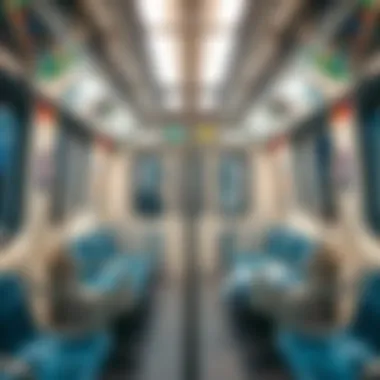
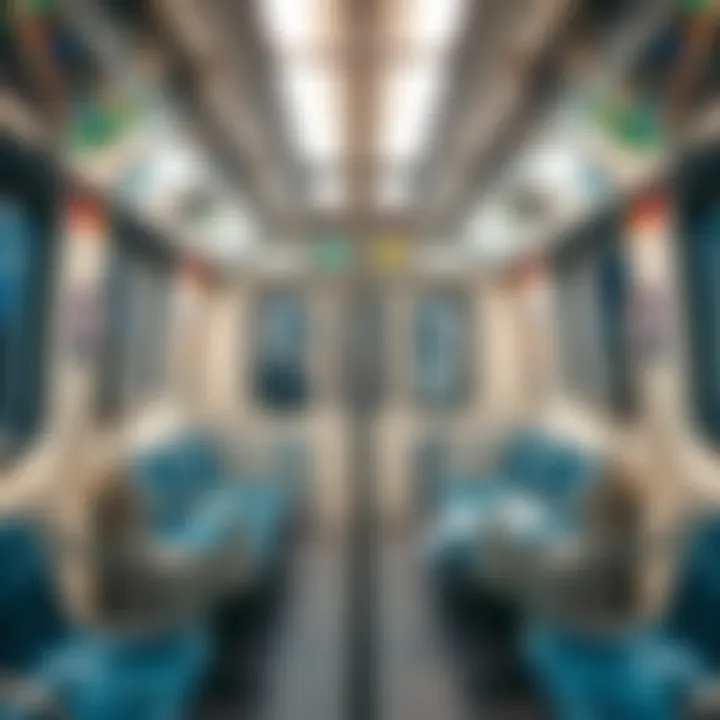
"A well-timed operation fosters not just mobility, but also economic growth."
Weekend Services
When the weekend rolls around, namely Friday and Saturday, the operational hours shift slightly. The metro runs from 10:00 AM to 1:00 AM on Fridays and from 5:00 AM to 1:00 AM on Saturdays. This adjustment is designed to cater to a different demographic, as leisure activities peak over the weekend. As families and groups of friends seek entertainment, shopping, and cultural experiences, the metro’s revised timing works to facilitate this flow.
During these days, the headways increase to about 7 to 10 minutes, providing enough flexibility while balancing service demand. The decreased frequency during weekends reflects the change in traveler profiles—fewer commuters and more leisure travelers, who typically are in no rush.
Holiday Schedule Adjustments
Public holidays introduce yet another layer of complexity to the operational hours. Special days in Dubai lead to adjustments in the schedule to accommodate the increased mobility of residents and tourists. On holidays, the metro timetable may extend from 5:00 AM to 2:00 AM or similar variants, depending on the nature of the celebration.
This flexibility is significant, particularly during events such as Eid or National Day, when many people tend to engage in festivities and communal gatherings. Therefore, understanding these adjustments can play a vital role for different stakeholders—be it homeowners anticipating influxes of visitors or investors looking at transport-oriented developments.
In summary, the operational hours from weekdays to weekends and during holidays illustrate the dynamic nature of the Dubai Metro system. Collectively, they showcase its fundamental importance in urban transportation and underscore how it continuously adapts to the community's needs.
Metro Time Efficiency
In today’s fast-paced world, time is often considered the most valuable currency. In Dubai, the Metro system stands as a pillar of urban mobility, and its efficiency is paramount for both daily commuters and occasional travelers. Efficiency in metro time translates to more than just getting from point A to point B. It encompasses how well the Metro integrates into daily life, its ability to adapt to passenger needs, and its role in enhancing the overall travel experience in a bustling metropolis.
Punctuality Metrics
Punctuality metrics serve as the backbone of any robust public transport system, including the Dubai Metro. According to recent surveys, the Metro boasts impressive punctuality rates, often exceeding 95%. This is no mere accident; rather, it’s the result of meticulous planning and execution. To better appreciate the significance of these metrics, consider the following aspects:
- On-Time Performance (OTP): This percentage signifies how many trains run on time compared to the schedule. A high OTP not only reflects well on the service but also instills confidence among users.
- Train Frequency: Short intervals between trains reduce wait times, effectively increasing the system's capacity to handle large volumes of passengers.
- User Satisfaction Surveys: Feedback from passengers regarding their experiences can shine a light on areas needing improvement and ensure trains meet user expectations.
"A reliable metro system is like a well-oiled machine: it keeps cities moving seamlessly and efficiently."
Factors Affecting Timeliness
Various elements influence the timeliness of metro services. Understanding these can provide insights into potential enhancements and areas for investment. Below are some critical factors:
- Infrastructure Quality: The condition of tracks, stations, and signaling systems directly affects punctuality. Well-maintained infrastructure is essential for minimizing delays.
- Operational Management: Efficient scheduling and dynamic response to unforeseen events, like equipment failure or adverse weather, are crucial. This requires a well-trained staff capable of making quick decisions.
- Passenger Volume: During peak hours, an influx of passengers can stretch the system. Strategies to alleviate congestion, such as increased train frequency or crowd management at stations, can significantly boost efficiency.
- Technological Integration: Advances in technology, including real-time data analytics and GPS tracking, can improve scheduling accuracy and enhance response times.
Metro time efficiency in Dubai is not just numbers and data; it's about people's lives and their experiences as they navigate this vibrant city. For investors and stakeholders, understanding the nuances of these factors is essential, as they inform long-term urban planning and real estate investments. The way the Metro can meet the demands of the city's growth will undoubtedly shape its landscape in the coming years.
Impacts of Metro Schedule on Urban Mobility
The Dubai Metro is not just a mode of transport; it is an essential cog in the wheel of urban mobility. Its scheduling plays a pivotal role in how effectively residents and visitors navigate the bustling city. Understanding this impact can offer insights into commuting patterns and lifestyle choices for many who call Dubai home.
Integration with Other Transport Modes
The efficiency of the Dubai Metro system is significantly enhanced by its integration with other transport modes. Buses, taxis, and even water transport services connect seamlessly with metro stations, making it easier for commuters to switch between different transport types. When the metro runs on time, the connections to these other services can be tightly coordinated.
- Bus Services: Numerous bus routes correspond with metro stations, effectively covering areas that are not directly served by metro lines. This coordination allows for an easy transition from one mode to another. For instance, the Al Ghubaiba bus station is connected directly to the metro, facilitating effortless travel across the city.
- Taxi Facilities: Strategically placed taxi stands at metro stations enable quick pickups for those who need to reach areas beyond the metro's reach. This integration is a boon for commuters, providing flexibility and reducing wait times.
- Water Transport: The ferry services connecting Dubai Creek and Dubai Marina to the metro stations extend the mobility reach further. These multimodal transport solutions mean that the Dubai Metro extends its influence beyond just trains, allowing a highly interconnected travel experience.
Such interconnectedness not only enhances the commuter's journey but also maximizes the public transport potential, making Dubai a more navigable city overall.
Role in Reducing Traffic Congestion
Traffic congestion is a persistent challenge in urban areas, and Dubai is no exception. However, the introduction of an efficient metro schedule has provided a keen solution to this problem. By offering a reliable alternative to private vehicles, the metro encourages more residents to leave their cars at home, effectively reducing the number of vehicles on the roads.
- Fewer Vehicles: Government reports indicate that with the rise of metro usage, there has been a corresponding drop in vehicular traffic during peak hours. This helps alleviate pressure on Dubai's roadways, leading to quicker commute times for those who still opt to drive.
- Environmental Benefits: Less traffic translates to lower emissions, which is crucial for a city that is striving for sustainability. As residents switch to public transport, the carbon footprint of their daily commutes decreases.
- Improved Quality of Life: With reduced congestion, residents can enjoy smoother commutes. This change not only makes the daily grind much easier but can also positively influence mental well-being by minimizing the stress associated with heavy traffic.
"Efficient metro scheduling is the backbone of a thriving urban transport network. It allows us to rethink how we navigate cities today."
In summary, the impact of metro scheduling on urban mobility in Dubai cannot be overstated. By ensuring smooth integration with other modes of transport and playing a significant role in reducing traffic congestion, the metro offers a viable solution to some of the city's pressing transportation challenges. This connectivity and efficiency are what enable urban planners, investors, and residents alike to envision a balanced and sustainable urban future for Dubai.
User Experience and Accessibility
In the fast-paced environment of Dubai, navigating the metro system effectively hinges on the elements of user experience and accessibility. These facets aren't just afterthoughts; rather, they serve as cornerstones in ensuring that the metro caters to a diverse population with varying needs. A seamless experience transforms the metro from a mere transit option to a vital component of daily life for residents and visitors alike. Thus, understanding how various amenities and services are tailored to meet user requirements is essential.
Station Amenities and Services
The Dubai Metro system goes above and beyond with its station amenities. Each station is designed with the commuter in mind, offering essential services and facilities that enhance user experience. For example, well-maintained restrooms, waiting areas, and screens with real-time service updates can significantly affect how comfortable and manageable a journey is.
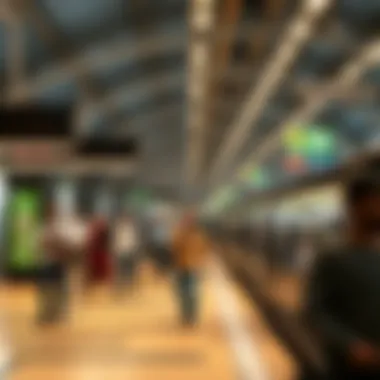
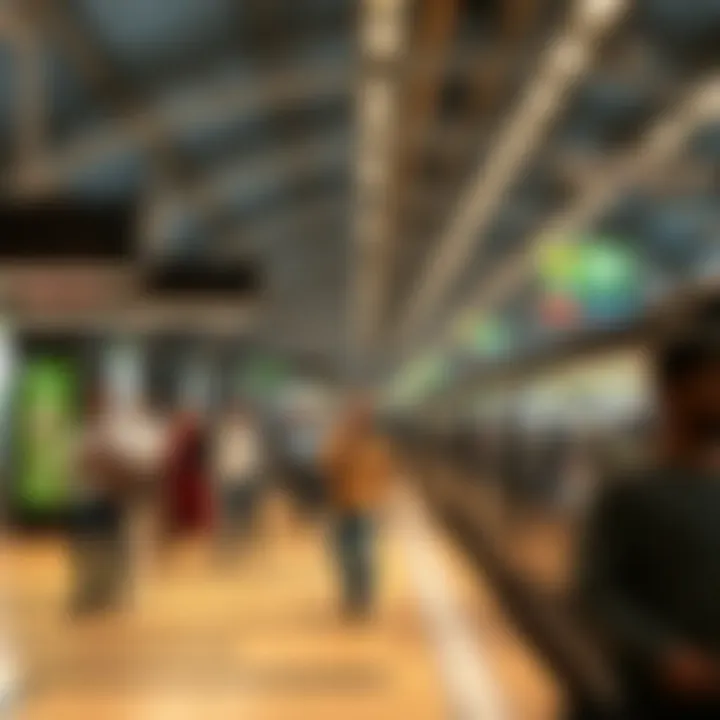
Consider the signage within the stations. It's not only about direction; clear indicators and multilingual displays ensure that everyone—from tourists to long-term residents—can navigate efficiently without second-guessing their choices. Moreover, services such as free Wi-Fi have been introduced, allowing commuters to stay connected during their travels.
Key amenities include:
- Waiting lounges equipped with comfortable seating.
- Food and beverage kiosks for quick snacks.
- Digital information boards that display live train statuses.
- Parking facilities for private vehicles.
These amenities collectively contribute to a more pleasant user experience, ensuring commuters feel valued and well catered to throughout their journey with the metro.
Accessibility for Differently-abled Individuals
In the pursuit of inclusivity, the Dubai Metro has made substantial strides in ensuring accessibility for differently-abled individuals. This is a critical aspect of the public transport infrastructure, as it reflects a commitment to accommodate all commuters. Stations are equipped with features like ramps, elevators, and tactile guide paths for visually impaired travelers.
It’s not just about the infrastructure. The staff at the stations receive specialized training to assist those who may face challenges while using the metro. Having personnel available to guide individuals, provide necessary assistance, and ensure safety adds a layer of reassurance to the user experience.
Additionally, key features supporting access include:
- Designated priority seating on trains.
- Assistance call buttons located conveniently for those who need help.
- Clear audio announcements to assist visually impaired passengers.
- Special pricing options for differently-abled commuters to encourage metro usage.
Ultimately, this emphasis on accessibility not only enhances the experience for all passengers but also promotes an inclusive public transport system. Investing in user-centric design fosters a sense of belonging among all users, eventually leading to higher patronage of the metro system.
"Accessibility is not just a feature; it's an essential element of any public transportation service that prides itself on being serving the community."
In summary, as the Dubai Metro continues to evolve, focusing on user experience and improved accessibility remains vital in shaping how individuals interact with public transport. From thoughtful station designs to comprehensive support for differently-abled individuals, these elements together paint a picture of a transport system that truly values its diverse riders.
Regional Connectivity and Feeder Bus Services
The Dubai Metro is not just a means of transportation; it's a vital puzzle piece in the city's intricate transit framework. One key aspect that enhances its significance is its regional connectivity and feeder bus services. This integration is pivotal, as it expands access beyond metro lines, allowing for a seamless travel experience across Dubai's urban expanse. The interplay between metro and bus services optimizes overall efficiency and ensures that even areas far from the central lines remain well-served.
Bus Integration Strategies
Bus integration strategies play a crucial role in maximizing the metro system's potential. By developing coordinated schedules between bus routes and metro departures, Dubai aims to minimize waiting times for passengers. This not only enhances the reliability of both modes but also serves to encourage increased ridership, which is essential for sustaining public transport's ecological benefits.
Some strategies include:
- Common Transfer Hubs: Creating dedicated transfer points where metro and bus services converge ensures smooth transitions for commuters. Key locations, like the Al Ras Station, become critical junctions where passengers can quickly switch between modes.
- Real-Time Information Systems: Integrating bus schedules with metro timing through mobile apps allows passengers to plan their journeys more effectively. This system increases transparency, helping ridership feel less like navigating a maze and more like strolling through a well-planned city.
The whole setup promotes efficiency as people start to rely on the metro-bus combination rather than their cars, leading to reduced traffic congestion.
Expanding the Network
Expanding the network of feeder bus services is an ongoing endeavor in Dubai. The aim is to create an extensive web of transport options that not only complement the metro system but also cater to emerging areas. With rapid urban development, certain neighborhoods demand customized bus lanes to adapt swiftly. This adaptation not only fosters growth but also opens doors for new investment opportunities.
Key considerations for network expansion include:
- Demand Assessment: Understanding the needs of residents in newly developed areas is vital. Surveys and studies gauge how many people would actually use these services.
- Route Optimization: A thorough analysis of travel patterns supports the creation of the most efficient routes. Feedback loops ensure routes are continually improved based on actual usage data.
- Sustainability Goals: As Dubai pushes towards environmentally friendly initiatives, evaluating the environmental impact of new bus services is essential. Routes should promote lower emissions by reducing the number of vehicles on the road.
"The connectivity between bus and metro services not only enhances the accessibility of urban areas, but also molds the future of commuting in Dubai, making wait times and environmental impacts a thing of the past."
For further reading on transportation developments in Dubai, you may want to check resources like Dubai Land Department or Dubai RTA.
This thorough examination of regional connectivity and its feeder bus services spotlighted unique elements that may easily fly under the radar but are fundamentally changing urban travel in Dubai.
Impact on Real Estate Developments
The relationship between metro access and real estate development is one that's hard to ignore. As the Dubai Metro continues to expand and influence urban mobility, its impact on property values and investment opportunities becomes increasingly significant. The convenience of having a metro station nearby often translates to higher demand for residential and commercial properties, making it a key consideration for investors, homeowners, and realtors alike. Moreover, this connectivity can reshape neighborhoods, typical patterns of living, and business dynamics.
Neighborhoods Benefiting from Metro Access
Several neighborhoods in Dubai are reaping the advantages of being close to the metro system. Areas such as Dubai Marina, Jumeirah Lakes Towers, and Downtown Dubai are prime examples where metro proximity enhances livability. Here’s how these neighborhoods have transformed due to their metro links:
- Dubai Marina: Known for its vibrant lifestyle and waterfront views, this area continues to attract a mix of expatriates and locals. The metro's presence has made daily commutes easier, elevating property demand and rental rates.
- Jumeirah Lakes Towers: The connectivity has positioned this area as a business hub with prominent offices and residences. Companies favoring easy transit options find this neighborhood appealing, driving both commercial and residential growth.
- Downtown Dubai: With landmarks like the Burj Khalifa and Dubai Mall, the addition of metro stations has attracted tourists and investors alike. Electric vibes abound, and as properties rise, so do the opportunities for businesses catering to both locals and visitors.
In these areas, the metro serves as a backbone for community development, allowing residents to weave in and out of urban life seamlessly. Its importance cannot be understated; land near metro stations often commands a premium price, setting the stage for sustained growth.
Investment Opportunities Near Metro Stations
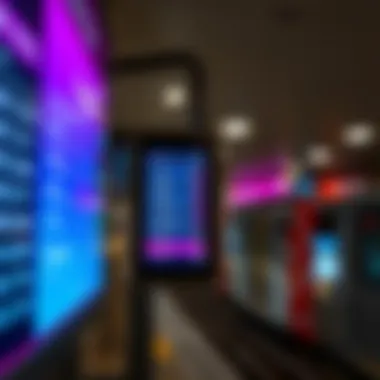
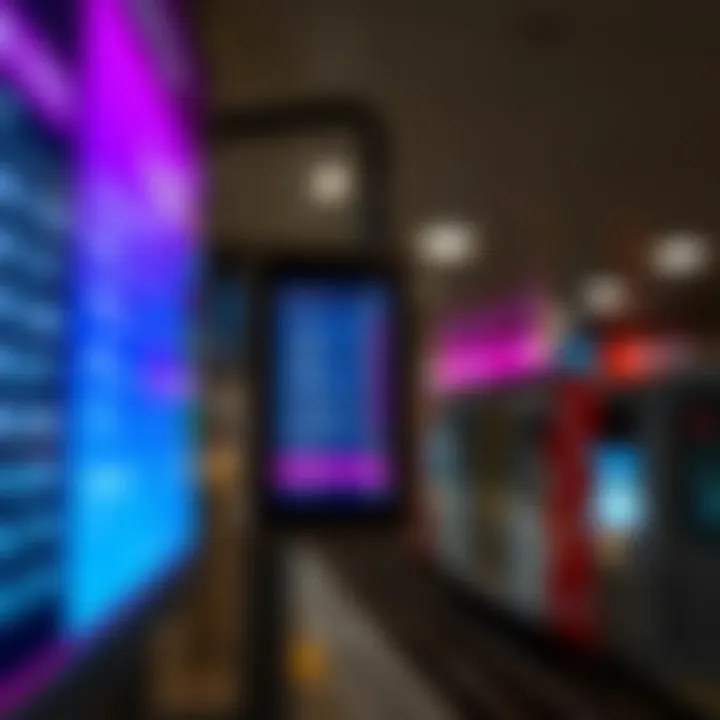
The spike in property values near metro stations also opens multiple avenues for savvy investors. Being near these transport hubs often guarantees a steady flow of renters and buyers. There are a few key factors investors should consider when evaluating opportunities:
- Higher Rental Yields: Properties within walking distance of metro stations typically show improved rental returns. Demand remains strong, especially in urban settings, as people look for easy commuting solutions.
- Long-term Capital Appreciation: As infrastructure continues to develop in line with metro expansions, property values are likely to appreciate. It’s a safe bet for those looking to hold onto real estate long-term.
- Diverse Options: Investment isn’t just limited to residential units. Commercial properties near metro stations can also yield significant returns, as we see an increase in foot traffic and potential business clients.
The bottom line is that investors must align their focus with the metro's roadmap. Sharpened awareness of current and planned metro expansions can lead to well-informed decisions, allowing proactive engagement in prime property markets.
"The connectivity offered by the Dubai Metro reshapes neighborhoods and offers fertile ground for new developments, forming a symbiotic relationship between urban planning and real estate investment."
Challenges Facing the Metro System
Examining the challenges that the Dubai Metro system faces is essential for comprehending its ongoing development and efficiency. As a public transportation system, it plays a crucial role in managing the city’s urban mobility. However, like any large infrastructure project, the metro has to grapple with various external and internal factors that can impact its overall performance.
Operational Challenges
The operational challenges of the Dubai Metro primarily revolve around service reliability and capacity management. The rapid growth of the population in Dubai has led to escalated demands on the public transit system. During peak hours, the stations tend to become somewhat crowded, challenging the capacity that the metro was originally designed to handle. For instance, the Green Line often sees more foot traffic than anticipated, leading to potential delays. Such overcrowding can make for an uncomfortable experience for commuters.
Moreover, the maintenance of the trains and tracks is another critical aspect that needs addressing. Regular wear and tear can lead to unexpected service interruptions. These outages not only frustrate passengers but can also deter them from relying solely on the metro for their daily commutes.
Adapting to seasonal tourism patterns also represents a challenge. During major events or holidays, the influx of visitors can exceed expectations, creating additional stress on the network. This seasonality requires efficient planning and flexibility in scheduling to accommodate the ever-changing dynamics of ridership.
Environmental Considerations
Environmental considerations are becoming increasingly central to discussions about urban transport systems, including the Dubai Metro. While the metro serves as a more sustainable alternative to individual car use, it isn't without its environmental impacts.
Construction-related noise and dust can disrupt the lives of nearby residents. For instance, ongoing expansion projects might involve clearing areas, which, while necessary for progress, can lead to biodiversity loss in the local environment. Balancing the expansion of the metro with ecological preservation is a delicate matter.
Additionally, there’s the question of electricity consumption. As the metro relies heavily on electric trains, ensuring that this energy comes from renewable sources is paramount. If fossil fuels primarily power these trains, the environmental benefits could diminish. Strategies for sourcing greener energy must be part of future planning.
In the early planning stages, it's vital for stakeholders to consider climate resilience, especially given Dubai's extreme weather conditions, which might affect infrastructure durability in the long run. Addressing these challenges requires a holistic approach that incorporates sustainable practices into the very fabric of metro operations.
In summary, while the Dubai Metro stands as a beacon of modern infrastructure, navigating its operational difficulties and environmental impacts will be crucial for its future success. Striking a harmonious balance among the demands of commuters, ecological sensitivity, and infrastructure reliability will determine the viability of this vital transportation network.
Ultimately, understanding these challenges allows for a more informed approach to urban planning and investment, highlighting the significance of continuous innovation and strategic foresight in evolving the metro system to meet Dubai's growing transportation needs.
Future Developments in the Metro Network
Future developments in the Dubai Metro network are not just a foresight into transportation evolution—they represent a commitment to enhancing urban mobility for residents and visitors alike. The orchestration of these projects plays a crucial role in ensuring the metro system remains efficient while accommodating the growing population. As Dubai continues to rise as a global hub for business and tourism, the metro's future is intrinsically linked with the city’s comprehensive urban planning goals. Exploring planned extensions and upgrades, alongside technological innovations, is essential in understanding how the metro will continue to function as the backbone of transportation.
Planned Extensions and Upgrades
As part of the strategic vision for the Dubai Metro, several extensions and upgrades are already on the drawing board. The aim? To broaden the reach of the network, ensuring it meets the demands of an expanding urban environment. Some of the key planned expansions include:
- Route Extensions: Expanding existing routes like the Red Line and adding new connections can break barriers that currently hinder seamless travel. For instance, plans to extend the Red Line towards the Expo 2020 site will enhance accessibility to major events.
- New Stations: Additional stations are critical to facilitate easier access for communities underserved by the current metro stops. The inclusion of stations in high-density residential and commercial zones is yielding a design that speaks to user convenience.
- Infrastructure Upgrades: Modernizing existing stations with improved amenities and signage can greatly enhance the user experience. This involves not only aesthetic upgrades but also ensuring that facilities are equipped to handle greater passenger volumes.
Quote: “Planned extensions are not merely an addition; they symbolize a dedicated effort by Dubai to foresee transportation needs and respond proactively.”
Such upgrades are vital for sustainable growth. However, their execution does require careful planning to minimize disruption during the construction phases.
Technological Innovations
In this rapidly changing world, technological innovations in the metro network are paramount. With digital transformation sweeping across industries, the Dubai Metro is no exception. Here are some key technological advancements shaping its future:
- Smart Ticketing Systems: The integration of contactless payment solutions paves the way for a more streamlined travel experience. Smart cards and mobile apps allow passengers to travel without hassle, positively impacting overall efficiency.
- Real-time Tracking: Implementing systems that provide live updates about train schedules improves passenger satisfaction and reduces wait times. Users can plan their journeys with greater certainty, minimizing uncertainty in their travel plans.
- AI and Data Analytics: Leveraging AI for predictive maintenance ensures that trains run smoothly. By analyzing data patterns, the metro can be proactive in handling issues before they escalate, leading to fewer delays.
Ending
In wrapping up our examination of the Dubai Metro, it becomes clear that understanding its operations extends far beyond the basic schedule. The significance of metro time is multi-faceted. For residents, it offers a reliable alternative to the often-congested roadways of the city, contributing to a smoother daily commute. For visitors, the metro provides an efficient way to navigate through the sprawling urban landscape without the hiccups of car rentals or traffic delays.
The metro's scheduling not only enhances personal travel experiences but also plays a crucial role in urban planning. As the city continues to grow, guidelines and timeframes established by the metro influence how neighborhoods develop around transit hubs. This creates valuable real estate alongside efficient transport options.
Summary of Key Insights
- The operational hours of the Dubai Metro are designed to accommodate both the busy workweek and the relaxed atmosphere of weekends, ensuring maximum usage.
- Punctuality and time efficiency are critical metrics that impact user trust and metropolitan flow.
- Integration with various modes of transport assists in creating an efficient city transport network, linking various neighborhoods and suburbs.
- Future developments promise further expansions, ultimately transforming urban mobility within Dubai.
Through this thorough analysis, we see that metro time holds not just importance but a profound impact on the socio-economic fabric of the city. It symbolizes a commitment to sustainable travel and an accessible urban environment.
Implications for Future Urban Planning
Looking ahead, the implications of metro scheduling extend into the realm of urban design and real estate investment. As the metro system continues to expand, planners must consider how new stations can influence local economies and populations. The accessibility granted by the metro can lead to higher property values, prompting strategic developments in residential and commercial projects.
Environmental sustainability is another factor intertwined with urban planning. Greater reliance on public transit systems like the metro can significantly reduce carbon footprints, making urban areas more pleasant to live in while addressing climate concerns. In essence, as planners evaluate future needs, integrating metro access points will be pivotal.
By balancing efficiency with accessibility, and aligning the metro's growth with community needs, Dubai can foster a transport system that's not only beneficial but also adaptable to changing dynamics. Ultimately, decisions made today regarding metro time and service expansion will lay the groundwork for a more interconnected and sustainable urban future.







